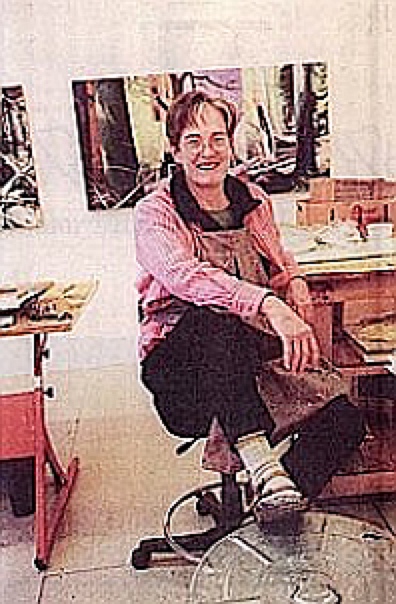LANDSCAPE PAINTER WHO SEES FORESTS AS WELL AS TREES
By WILLIAM ZIMMER
New York Times, Sunday, December 24, 2000, CT 15*
She is a landscape painter with a purpose. For the past
decade the work of Prilla Smith Brackett has emphasized
contrast: unspoiled old-growth forests are depicted along with
evidence of modern-day environmental decline. She is interested
in realistic depiction and in using materials and techniques to
bring out her ecological message.
Last year Ms. Brackett, who lives in Cambridge, Mass., organized
a traveling exhibition, "Ancient Forests and City Trees" now at
the gallery at Housatonic Community Technical College in
Bridgeport. Along with many works on paper, the show contains
a number of large paintings with the group titles "Remnants"
and "Silent Striving."
In a recent interview, she talked about her work.
Q. What was the impetus for the way you show nature in your
work?
A. Ten years ago. my family hosted a high school exchange
student from Colombia. His family invited us to spend the Christmas break in Bogota. I told them I'd
like to see a jungle. I was realty impressed by the tropical forest there and made several pieces
contrasting tropical forests with typical ones in the Northern Hemisphere.
Later, I wanted to depict really northern forests and was inspired by those in Alaska on a trip I took
with my mother. But I couldn't afford to keep going there. However rather close to home, in New
Hampshire and Maine, are pockets of old growth forest through which my family and I hike The trees
I find have both a spiritual energy and sensual power.
There's also a tie to my past here. My affinity for trees has deep roots. I was born and raised in West
Hartford. My father became interested in forestry late in life and after he retired, got a degree in it at
Yale. He raised evergreens, which the public could cut for Christmas trees, on land he bought near
Canton.
Q. Your current major pieces might be referred to as diptychs, but of an unusual sort. How do you
show contrast by means of collage?
A. Yes those pieces are called "Remnants" which refers both to the pockets of old forest and the
pieces of canvas I use for the collage elements. The collage pieces are very irregular; they're
fractured like shards, and this idea of fracture furthers my ideas. The collaged piece might depict a
pristine forest and It will overlie a forest in decline.
In the case of the few "Remnants" paintings that are subtitled "Communion," the contrast will be
one of wilderness with urban trees. The works of man - fences roads and buildings - are prominent
Sometimes the contrast is heightened by color. In one "Remnants" painting a shard of green forest
cuts across a composition predominately in brown and gray. In many paintings, like this one, the
overlay might work as a sort of prism onto the pristine past, but it's a shield, too, meaning we can't
go back to the way things were.
Q. A writer in Boston compared your imagery to Alfred Hitchcock. Do you agree?
A. There might be a similar eeriness. A forest is a very violent world. When you walk through a forest
you come across moss-covered branches that are twisted in fantastic ways. These find their way into
my work. In the city, trees are often horribly neglected. And the shards themselves are evidence of
something broken or shattered.
Q. There are two pieces called "Silent Striving #1" and "Silent Striving #3" that are composed of a
number of small panels. Why did you choose this method?
A. The elements in the panels are all related, of course, but you're presented with a number of
vantage points: the base of a tree, views into the high branches, or even a shadow cast by a tree. A
number of panels. show fallen trees. I see a contrast between freedom and restraint as a number of
these views are in urban settings. The organization of these panels might seem informal, but it's:
tightly arranged. I work from sketches and snapshots. One year, I, determinedly made a drawing a
day, and these "Strivings" continue that kind of commitment and close intimate observation
Q. Would you call yourself an activist?
A. Not as much as I'm sometimes made out to be. l did do a recent stint of social activism. That took
me back to my college days - my husband and I met at Berkeley in the 1960's. In 1999 I received a
foundation grant for the City Trees Millennium Project in Boston. I went into the inner city and
worked with children. I told them we'd explore what it takes to be a tree in the city.
At first their drawings of trees were the usual stick topped by a ball with a sun in the corner. But
they soon began so look at actual trees. I gave them Magic Markers to work with so they had to
draw without erasing. I wanted them to just go with their feelings and ideas. Their drawings were all
collected to form a kind of quilt that has been shown around the city.
Q. What are you working on now?
A. Skies. The notion of change is of course very strong here, too. This time in the shifting clouds.
*Copyright © 2000 The New York Times
(Photo: Ed Stitt. The article had two other color photos.)
